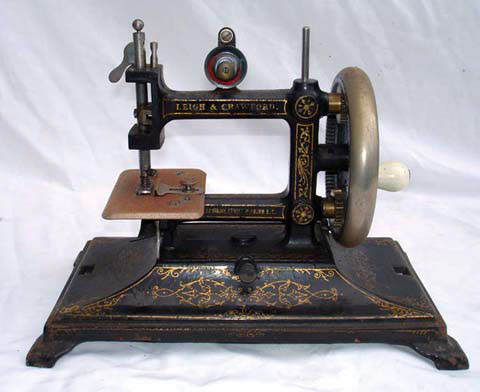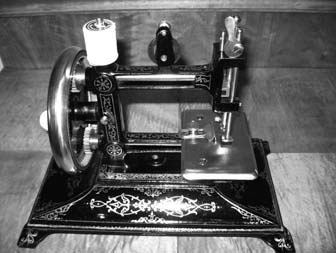Colibris Gather in Australia

A German Colibri machine badged by Leigh and Crawford
A quartet of 'Colibri' miniature chain stitch sewing machines has gone to Australia. Here are their stories: part one is by Brenda Hyde (pictures by the author).
Part 1: Finally – A Result! After many years of searching for a Bremer & Bruckmann miniature sewing machine, I have found a near perfect specimen. I know I've not been alone in my quest for this machine as other members have been hunting for it too.
My story goes like this:
I spotted one, the Colibri model (with the bird decal and tool compartment) on ebay before Christmas. As the auction only had a few minutes to run, I immediately thought to my self – "Wow, only two bids, and cheap as chips" so I entered a bid and all hell broke loose; the refresh button couldn't keep up with the rapidly changing dollars, and before I could blink, the auction ended and I missed out as the clock had beaten me. The disappointment was huge, I didn't know whether to laugh or cry as I really believed this one was mine!
After thinking about just how close my bid was, I decided to email the seller via ebay in case the deal didn't go through and ask if he would advise me if the machine became available.

Photo 1
Rear view
The seller responded telling me the machine was already on its way to AUSTRALIA!!!! And, he had a second B&B but, it had a fixed base with a gold filigree decal & was in neat mint condition, a different Colibri model. After many emails to and fro, we agreed on a price and a second Bremer & Bruckmann was also on its way to AUSTRALIA.
After I settled the deal I decide to look at the one I had missed to see if I recognized the ebay buyer name – it was rather unusual and as I had just met a new ISMACS member with the same Christian name, at the ISMACS AGM meeting in September, I decided to contact the member & see if she was the lucky recipient. She was; and pleased as punch to have the machine as she too had been looking for a long time.
Then I did a little……BOASTING to a 3rd ISMACS member who I knew was also looking for a B&B. Two days later I received an email from his wife telling me her husband had just found his Christmas present: a Bremer & Bruckmann Colibri model miniature sewing machine.

Photo 2
Front view
There are differences between these B&B machines, even amongst examples of the same model. My machine as shown in photos 1, 2, and 3 has the larger base of the Colibri, a fixed base (see centre screw under the bottom arm) without the tool compartment. There are no markings on the machine except for a serial number under the cloth plate and it has a delicate gold stencil decal in place of the Colibri (bird) decal.
I know very little of the history of these beautiful machines, but after a few emails I have received the following information.
The Bremer & Bruckman Company was founded in 1868 in Braunschweig Germany. They produced the 'Original Brunonia' in hand and treadle forms in 1875 and the 'Brunonia' Models 1, A and B in 1881.
The 'Original Liliput' toy was introduced in 1888 and followed by the slightly larger based model, the 'Colibri' and the 'Magician'. (Information courtesy of Graham Forsdyke)

Photo 3
Wheel view

Photo 1
Rear view
Part two of our article is by Rob Sanders (pictures by the author).
Toy or Miniature?
Bremer & Bruckmann, were one of many German manufacturers of sewing machines. They are best known for their small chain stitch machine which was introduced in 1888 as the 'Original Liliput'.
Around 1895 the machine was slightly updated with a larger cast iron base that had a small compartment built into it to hold the spare feet. These later machines were often sold as the 'Colibri' model, although they often carried no name at all.
The distributor in the UK was Leigh & Crawford and it is not uncommon to see machines with these names on them in place of the German name. Regardless, all machines carried the B&B logo on the bed of the machine so there is no doubt who actually made them.
The Colibri machines were also supplied with a sheet iron cover with lovely gold floral decals around the border and a larger decal in the centre of the cover, both back and front, depicting the birds similar to those decorating the base of the machine. I am not sure if covers were supplied with all machines, but somehow I suspect this was an optional extra which you paid more for.

Photo 2
Front view
Most machines that I have seen for sale do not include the cover: perhaps as few as one in ten still have it. (The cover was supplied for machines taken to the tropics as it was described as 'termite proof'. Only the 'large base machines', such as Rob's, have the slots to which the cover attaches. There are no such slots on Brenda's which has a smaller base and could never have had a sheet iron cover. Ed)
This was one machine that I had looked at many times and one I had decided that I would really like to have in my collection. However every time I saw one for sale it was either too expensive, too far away (although this is not quite true), or not in good condition.
Not long before Christmas one appeared on the internet that was complete, including the tin cover and the price looked ok, but on the down side it was in Argentina and the seller had not sold that much. Foolishly perhaps we bid on it, and possibly because it was so close to Christmas and people had other things on their mind we also won this lovely little machine.

Photo 3
Sheet iron domed cover
We were informed by the seller that he would pack it really well and not to worry. However the next email said that Fedex was really slow at the moment and he could send it by post but there would be no insurance.
This was not what we wanted and even though it cost more and possibly could take longer we still had it sent Fedex and insured. When the parcel did arrive here, the "good" packaging turned out to be a few pieces of foam in a box. The cover had just been put on the machine and had spent the last 5000 or so kilometres rattling around against the machine.
It was at this point I really started to worry. The box was torn open in record time and except for a little more damage to the paint on the base and the cover being somewhat bent out of shape, everything else was ok.
After more than a little cursing of people who have no idea how to pack something properly I set to work fixing the damage. The cover was carefully pushed back into shape and given a clean. Next the machine was completely stripped down and every metal part polished, the body cleaned and also carefully polished and then put back together.
The results speak for themselves. What was initially a fairly average machine now looks in condition 8 and even better, it has the cover. A final bonus was that in the tool box in the base of the machine there was a small oil can. Wether this is an original or not doesn't really matter it looks right and it certainly came with my machine.

Here is a picture of yet another pair of 'Colibri' machines now at home in Australia! (Ed)
ISMACS is an organization totally independent of all sewing-machine manufacturers, past or present and is not affiliated with any of the companies mentioned in these pages. Please Note: Do not contact any ISMACS official in an attempt to solicit a valuation - it is not possible other than by hands-on assessment and your request will be ignored.
All rights reserved by ISMACS, under International and Pan American copyright conventions. Reproduction or copy of this page, in any form, in part or in whole, is strictly prohibited, without prior, written permission.






